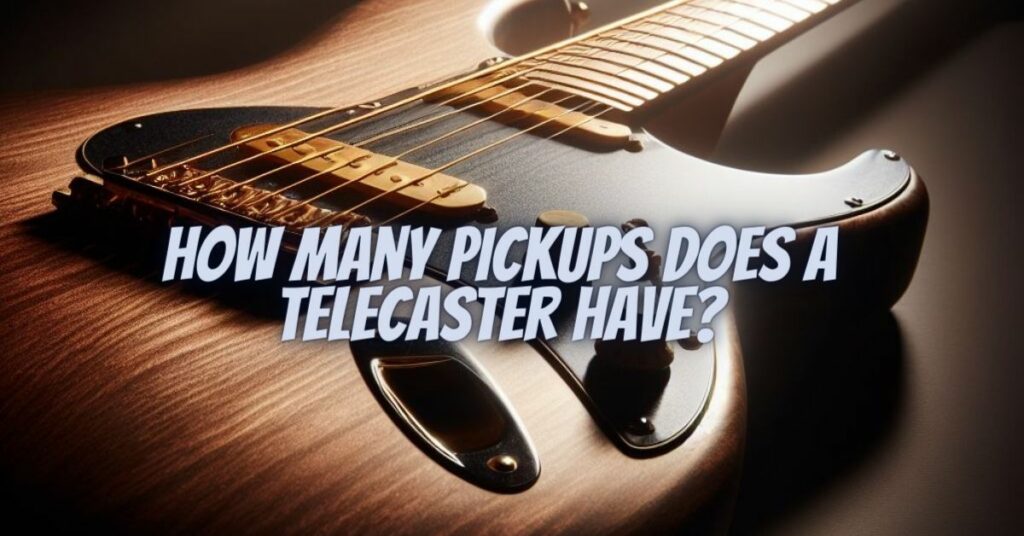The Fender Telecaster, affectionately known as the “Tele,” stands as an enduring symbol of innovation and simplicity in the world of electric guitars. Revered for its unmistakable tone, timeless design, and legendary history, the Telecaster has sparked curiosity about its pickups. How many pickups does a Telecaster have? In this article, we will embark on a journey through the decades to uncover the various pickup configurations that have defined this iconic guitar.
The Origin of the Telecaster
Before delving into its pickups, let’s briefly trace the origins of the Telecaster. Introduced in 1950 by Leo Fender and his team, the Telecaster was groundbreaking for its time. It was the first commercially successful solid-body electric guitar and marked the beginning of Fender’s legacy in the electric guitar industry.
Original Telecaster Pickup Configuration
The very first Telecaster model, known as the “Esquire,” featured a single-pickup configuration. This pickup was a single-coil design known as the “Broadcaster” pickup. The Esquire’s simplicity was a hallmark of its design, making it a workhorse guitar with a distinctive twangy sound.
The Name Change and Evolution
In 1951, Fender briefly changed the name from “Broadcaster” to “Telecaster” due to a trademark dispute with Gretsch. Alongside this name change, Fender introduced a crucial update to the Telecaster’s design: the addition of a second pickup.
The Two-Pickup Telecaster
The introduction of the second pickup, positioned in the neck position, transformed the Telecaster’s tonal capabilities. This “two-pickup” Telecaster became immensely popular and remains the most common configuration to this day. With a pickup in both the bridge and neck positions, players could blend the brightness of the bridge pickup with the warmth of the neck pickup, creating a more versatile and balanced instrument. This configuration gave birth to the classic Telecaster sound, characterized by its signature twang, clarity, and punch.
Three-Pickup Telecasters
While the two-pickup Telecaster became the standard, Fender also produced models with three pickups. In these “three-pickup” Telecasters, an additional middle pickup was placed between the bridge and neck pickups. This configuration, often referred to as “Nashville-style,” allowed for even more tonal options. Guitarists could select various combinations of pickups, achieving unique quacky sounds when combining the middle pickup with either the neck or bridge pickup.
Humbucker-Equipped Telecasters
In response to the demand for humbucking pickups and thicker tones, Fender has produced Telecaster models equipped with humbuckers. These humbucker-equipped Telecasters provide a powerful, sustain-rich sound, making them ideal for genres like rock and metal. While they deviate from the traditional Telecaster sound, these models cater to a different set of players seeking a heavier sonic palette.
Customization and Aftermarket Options
One of the strengths of the Telecaster lies in its modularity and adaptability. Many guitarists choose to customize their Telecasters by swapping out pickups, adding additional switches, or even installing a second pickup in unconventional positions. This customization allows players to tailor their Telecaster to their specific playing style and tonal preferences.
The Fender Telecaster, with its rich history and iconic design, offers a variety of pickup configurations to suit the needs and preferences of guitarists across different genres. From the single-pickup simplicity of the original Esquire to the classic two-pickup design that defined Telecaster tone, to the versatility of three-pickup and the power of humbucker-equipped models, the Telecaster has evolved while retaining its unmistakable character.
So, when asking, “How many pickups does a Telecaster have?” the answer depends on the specific model and player’s choice. While the traditional two-pickup configuration is the most recognized, the Telecaster’s versatility and adaptability have allowed it to remain relevant and beloved by generations of guitarists. Whether it’s the twangy country sound, classic rock tones, or heavy metal riffs, the Telecaster continues to be a versatile and enduring icon in the world of electric guitars.


